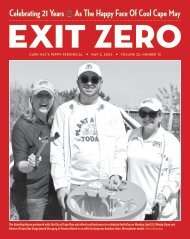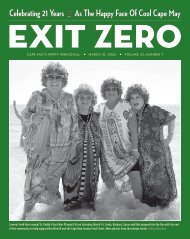Create successful ePaper yourself
Turn your PDF publications into a flip-book with our unique Google optimized e-Paper software.
Despite the late date, I went to the<br />
hawk watch on a day with NNW<br />
winds. Under ice-blue skies, 20-30<br />
die-hard hawk watchers were<br />
treated to lots of Red-shouldered<br />
and Red-tailed Hawks, a bunch of Northern<br />
Harriers and all the usual late migrants —<br />
bluebirds, cedar waxwings and American<br />
Robins. One thing we did not have was Pine<br />
Siskins. This wave of winter finch seems to<br />
have moved on. Where I had 40 at my feeders<br />
last week, yesterday there were three.<br />
The American Goldfinch was the dominant<br />
finch, but word is that Common Redpolls are<br />
not far behind. These red-capped Subarctic<br />
breeders and winter nomads sometimes<br />
arrive in hordes in January and February,<br />
once they’ve consumed all the birch catkins<br />
in New England. One cold February morning,<br />
I watched waves of redpoll come in off the<br />
Atlantic and festoon the withered goldenrod<br />
like animate Christmas Tree ornaments and<br />
enliven the air with their brittle call notes.<br />
The point of this essay is to point out<br />
Bird Droppings<br />
Dispatches from the nation’s birdwatching capital… by Seymore Thanu<br />
that Fall migration doesn’t end on November<br />
30. The hawk counter’s contract may end,<br />
but it doesn’t mean the hawks won’t migrate<br />
when winds turn cold and northerly. A big<br />
dump of snow in New England will send<br />
big burly buteos south, seeking open ground<br />
where rodents are not sheathed in a layer of<br />
snow. I’ve seen Rough-legged Hawks arrive in<br />
March, driven south by a blanketing blizzard.<br />
While most puddle ducks have already<br />
arrived, sea ducks and other sea birds will<br />
continue south into January. A dozen Black<br />
Scoters flew over the hawk watch while I<br />
was there. Loons, Northern Gannet and the<br />
odd alcid or two might be seen from the<br />
Avalon Seawatch. Or grab your binoculars<br />
and scan offshore. The skeins of birds writhe<br />
like strands of smoke along the horizon. Surf<br />
and Black Scoters are most common. Whitewinged<br />
Scoters flash white wing patches and<br />
eiders are overall larger. You may even see the<br />
odd puddle duck migrating with scoters.<br />
Winter is the season for special treasures.<br />
A walk down to Stone Harbor Point may garner<br />
a treasured look at Snowy Owl. It will certainly<br />
produce Herring Gulls whose keening<br />
cries make the air seem 10 degrees colder. The<br />
belly-laugh grunts of the Great Black-backed<br />
Gull cast aspersions upon the human preoccupation<br />
with meaning.<br />
The meaning you seek is written in the<br />
tracks laid by tiny sandpipers, erased by the<br />
incoming tide. Enjoy your walk along unpeopled<br />
beaches, a special gift of the season.<br />
Health Insurance Open Enrollment<br />
GET COVERED NJ<br />
• New Jersey’s NEW State Based Health Exchange<br />
• Annual Health Insurance<br />
Open Enrollment November 1 - January 31<br />
This is your opportunity to enroll for 2021.<br />
CALL TODAY FOR AN APPOINTMENT... THERE IS NEVER A FEE FOR OUR SERVICE<br />
Cape Life & Health LLC<br />
Dan Coakley • 609-886-3700 • www.myclh.com<br />
November 26, 2020 EXIT ZERO Page 47


















